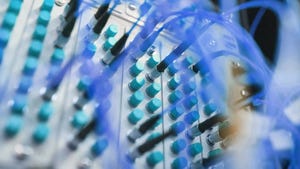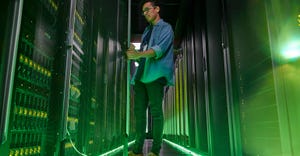Cisco Enters Data Center Switch Silicon Market, Supplying Microsoft, Facebook
The networking giant is going after the hyperscale market, where clients design their own hardware.
December 12, 2019

Ian King (Bloomberg) -- Cisco Systems Inc. has started supplying switch chips to major data center operators, including Microsoft Corp. and Facebook Inc., opening up a new avenue to win orders from some of its largest networking-equipment customers.
Cisco Silicon 1 is a switch semiconductor that’s already being used by Microsoft and Facebook in crucial networking equipment, the companies said Wednesday at an event in San Francisco. San Jose, California-based Cisco is now offering the chips, which it says are the fastest in the industry, to all of its customers, regardless of whether they buy its networking machinery. Previously Cisco’s chips were only available as components of its machines.
The shift toward standalone chip sales is another departure from the business model that made Cisco one of the biggest companies in the technology industry. Cisco’s expensive proprietary combinations of hardware and software make up the backbone of much of the internet and corporate networks, and these products generate the bulk of the company’s revenue. The new initiative has the potential to attract business from customers who want to build their own machines instead of buying whole packages. It also puts Cisco in direct competition with its suppliers, Intel Corp. and Broadcom Inc., which also make switch chips that the networking equipment maker uses in some of its products.
“From today -- and this is something that some of you never thought we’d do -- some of our customers will buy our silicon and build their own products if that’s what they choose to do,” Chief Executive Officer Chuck Robbins said at the event. “We really want our customers to consume this technology in any way they want.”
As the internet infrastructure business moves away from suppliers who provide all the needs through locked-down combinations of hardware and software, Robbins has been pushing Cisco to adapt by becoming a bigger supplier of networking services and software. On his watch, software has risen to provide about 11% of revenue. Hardware still generates more than half of sales.
Cisco shares rose less than 1% to $44.24 at 2:02 p.m. in New York. The stock gained 1.8% this year through Tuesday’s close.
The move into selling components is an attempt to win orders from the hyperscalers, such as Microsoft, Google and Amazon.com Inc.’s AWS, a group that has increasingly turned away from Cisco’s offerings and equipped their data centers with computers and networking gear designed in house. Those big cloud-computing vendors contribute as little as 2% of Cisco’s total sales, according to Raymond James analyst Simon Leopold.
Switch chips perform the crucial function of deciding where packets of data should go in a network of computers. They are designed to handle that task at great speed, and only a few companies have been successful in the market. Broadcom is the biggest provider of this type of chip as an individual component and has as much as 80% share, Leopold said. Intel took a bigger interest in the market in June when it bought startup Barefoot Networks.
Cisco’s new offering will combine the attributes of both switch and routing chips, the company said. It’ll be able to move data very quickly and still be programmable, carrying the ability to have its function changed. Routing, directing traffic among networks, is typically conducted by groups of chips that bring other attributes but are unable to direct data fast enough for modern internet traffic loads. One chip providing all of the functions will simplify the operation of networks by eliminating the need for different layers of software, Cisco executives said.
Offering up what was previously guarded as a proprietary advantage shows a flexibility at Cisco that has been increasing as Robbins works to transform the company. Analysts predict the build-it-yourself approach to networking, pioneered by the large cloud-service operators, over time will be copied by companies looking to reduce the cost of their data-center spending. That corporate market is one of Cisco’s biggest sources of revenue.
Cisco’s equipment, including its chips, is designed by the company and manufactured by a third party, which it hasn’t identified.
The company also announced a new router machine at the event, designed to better serve as the backbone for new fifth generation, or 5G, cellular networks. The Cisco 8000 will be based on the new chip. The company also unveiled plans for products that will support faster data transmission speeds over fiber-optic cables. Like the rest of the networking industry, Cisco is positioning itself to be a main provider of equipment for the predicted surge in internet traffic and data created by the proliferation of mobile systems.
About the Author
You May Also Like









